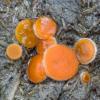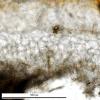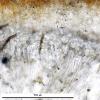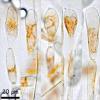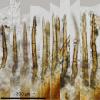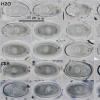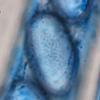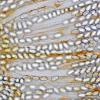
21-12-2025 21:40
Isabelle CharissouBonjour, j'aimerais connaitre les rÃĐfÃĐrences de

21-12-2025 21:32
Pol DebaenstHello, Garden, Burgweg 19, Veurne, BelgiumOn 10/1

21-12-2025 21:31
Pol DebaenstHello, Garden, Burgweg 19, Veurne, BelgiumOn 10/1

21-12-2025 21:31
Pol DebaenstHello, Garden, Burgweg 19, Veurne, BelgiumOn 10/1

20-12-2025 23:08
Patrice TANCHAUDBonsoir, rÃĐcolte sur sol sablonneux dans l'arriÃ

21-12-2025 09:32
Hello.A tiny ascomycete found embedded in wood in

20-12-2025 15:47
Mirek GrycHi.These grew on pine wood that was heavily covere
 Good morning
Good morningI know August is a holiday month, but now I have time to send this species.
This Cheilymenia was in a snowfield (see first picture) and I think there is not doubt about his identification, but I prefer your opinion.
Spores eliptical and slightly ornamented, size (18.6) 19.3 - 21.9 (22.5) x (10.3) 10.6 - 11.7 (12.9) Âĩm;Â Q = (1.6) 1.7 - 2.0 (2.2) ; N = 91;Â Me = 20.6 x 11.2 Âĩm ; Qe = 1.9.
Hairs size (222.7) 235.0 - 401.2 (435.2) x (16.4) 19.1 - 27.5 (37.2) Âĩm
N = 27; Me = 319.6 x 23.9 Âĩm
Moniliform paraphysis and croziers.
Hifal system at base very developed.Â
Thank you for your opinion

You do not specify the substrate, but it looks good on the picture that there is dung. This is a difficult species to determine, but I think C.denissi corresponds to your description. Have you also checked the length of asci?
Michel.

Of course, substrate is cow dung, and this are measures of living asci at 600x:
(267.5) 280.0 - 310.6 (326.3) x (17.1) 17.6 - 20.4 (21.2) Âĩm; N = 24; Me = 295.6 x 19.1 Âĩm
Why is so difficult to determine this species? According to Moravec, the nearest species is C. liskae, who have shorter hairs (90-300 x 10-30), bi, tri o multifurcate; asci shorter and wider (150-180x18-27) and longer spores (18-22,5 x 10-13).
The doubt is that Moravec spores measure for C. denisii are 14-21 x 8-13,5, and asci 170-240 x 13,5-18, both shorter than mine, perhaps died material?
Thank you Michel

surely the asci show such enormous shrinkage as is seen between your and Moravec's ascus sizes. The spore data are more equal when considering perhaps immature spores included in Moravec's data. Moravec probably mostly measured dead elements as far as I know his papers.
I have only a few pages of Moravec's monograph. On Fig. 23 I wonder why he figured a dead (b) and a living ascus (c) and addressed them to different varieties. Was he unaware of ascus shrinkage?
In your sample I am impressed especially of the carotenoid crystals in the paraphyses. I know this feature only in Scutellinia, and in one species of Cheilymenia (crucipila), which was later transferred to Scutellinia, I think for molecular reasons.
Maybe Cheilymenia dennisii is also a masked Scutellinia despite of the low lipid content in the spores?
Â
Zotto

I think my measures are on living state (attached picture).
Another discrepance with Moravec is about croziers, he said no croziers, and I think mine has it.
Very interesting hypothesis about Cheilymenia / Scutellinia Âŋ?, of course I have no answer.
Thank you

But I was wondering about the ascus base, it looks to me like lacking croziers.

Thanks.


